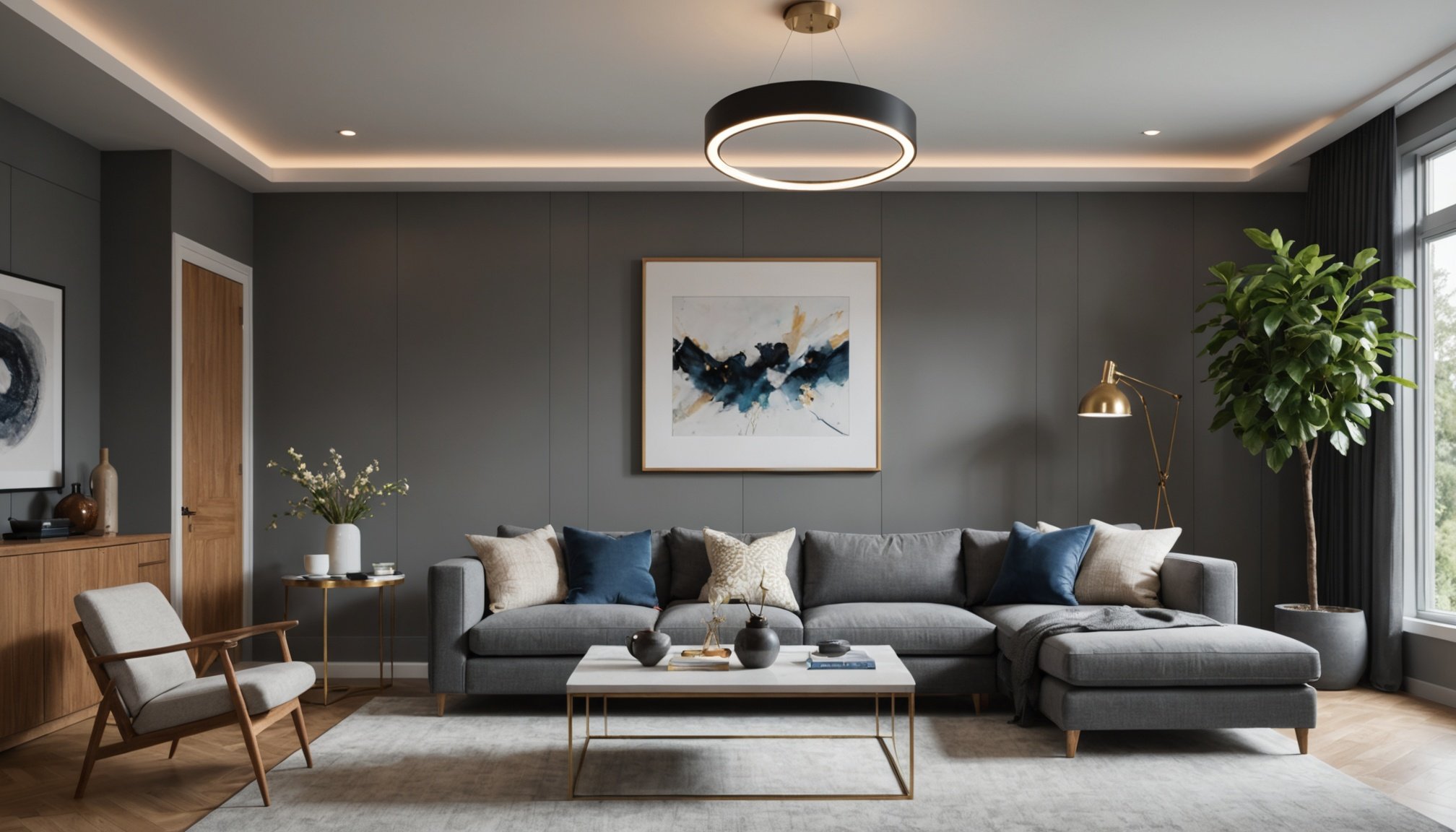Transform Your Space: How Smart Lighting Can Elevate Your Mood and Skyrocket Productivity Effortlessly
In today’s fast-paced world, the environment in which we live and work plays a crucial role in our overall well-being and productivity. One often overlooked but highly impactful aspect of this environment is lighting. Smart lighting, in particular, has the potential to transform your space, enhancing your mood and boosting your productivity with ease.
The Impact of Lighting on Your Mood
Lighting is not just about illuminating a room; it has a profound effect on our emotions and mental state. Different colors and intensities of light can evoke various emotions and influence our behavior.
Topic to read : Harnessing every step: exploring how piezoelectric materials could illuminate our streets
Color Psychology in Lighting
The color of the light you use can significantly impact your mood. Here’s a breakdown of how different colors affect us:
| Color of Light | Impact on Mood |
|---|---|
| White | Cleanliness, Purity, Virtue |
| Orange | Happiness, Energy, Vitality |
| Violet | Calm, Relaxation, Sleep |
| Red | Love, Passion, Anger |
| Yellow | Hope, Happiness, Deception |
| Blue | Energetic, Responsible, Calm, Sadness |
| Green | Abundance, New Beginnings, Nature |
For instance, if you’re designing the lighting for a home office, using cool white lights with a blue hue can keep you energetic and improve productivity. On the other hand, warm white lights with yellow undertones are ideal for bedrooms, facilitating better sleep[1].
Also to discover : Revolutionizing crisis management: the role of ai-driven virtual assistants in instant language translation
Designing Your Smart Lighting System
Creating an effective smart lighting system involves several steps, each designed to optimize the functionality and ambiance of your space.
General Lighting
First, you need to establish a general lighting source for the room. This can be achieved with hidden lighting effects, such as cove lighting. This type of lighting provides a uniform illumination without harsh shadows or glare[1].
Task Lighting
Identify areas where you need task lighting. For example, in a kitchen, you would focus on the cooking island, cooking area, and dishwashing zone. These areas require targeted lighting to ensure you can perform tasks efficiently[1].
Accent Lighting
Accent lighting adds both beauty and functionality to your space. Lighting the underside of furniture is a key target area. This not only enhances the aesthetic appeal but also adds practicality. You can use LED strips or recessed spotlights for this purpose[1].
Creative and Flexible Options
You can also get creative with your lighting design. Instead of using pre-made luminaires, consider DIY LED light strips. For example, you can create a suspended design by placing irregularly shaped LED strips on a suspended panel. This can serve as both task lighting and decorative lighting[1].
Smart Lighting Technologies
Smart lighting is more than just about turning lights on and off; it’s about creating an intelligent and adaptive environment.
Automated Systems
Modern smart lighting systems often come with automated features such as motion sensors and smart controllers. These systems can adjust the lighting based on your presence, time of day, and even your habits. For instance, smart controllers connected to AI can learn your habits and adjust the lighting, temperature, and ventilation accordingly to maximize comfort and energy efficiency[3].
Color Changing Technology (CCT)
Color Changing Technology (CCT) allows you to adjust the color temperature of your lights throughout the day. In the morning, a cool white light (5000K-6500K) can help you feel more energetic and focused. In the evening, a warm white light (2200K-2700K) can create a relaxing atmosphere, preparing you for rest[5].
Integrating Natural Light
While smart lighting is incredibly versatile, it’s also important to make the most of natural light.
Maximizing Natural Light
If you have large windows in your space, use mirrors to reflect natural light and illuminate the room. This not only reduces the need for artificial lighting during the day but also enhances the overall ambiance of the space[1].
Balancing Natural and Artificial Light
It’s crucial to strike a balance between natural and artificial light. Natural light has been proven to improve mood and mental health, but it may not be available at all times. Smart lighting can fill this gap by mimicking natural light conditions. For example, using LED lights that mimic the color temperature of natural daylight can help maintain a consistent and healthy lighting environment[2][5].
Tips for Implementing Smart Lighting in Your Home and Office
Here are some practical tips to help you implement smart lighting effectively:
Home Office Tips
- Use CCT Lights: Adjust the color temperature of your lights to match your daily activities. Cool white lights in the morning and warm white lights in the evening can significantly impact your productivity and mood[5].
- Layered Lighting: Use a combination of general, task, and accent lighting to create a well-rounded lighting plan[1].
- Smart Controllers: Invest in smart controllers that can be managed via mobile apps or voice assistants for ease of use[5].
Office Tips
- Color Scheme: Use colors like blue and green in your office lighting to promote creativity and innovation. Red accents can be used in areas requiring high concentration[2].
- Automated Systems: Implement automated lighting systems that adjust based on occupancy and time of day to optimize energy efficiency and comfort[3].
- Natural Light Integration: Ensure that natural light penetrates the office space as much as possible. If this is not feasible, use indoor plants to bring in a natural element[2].
Energy Efficiency and Smart Lighting
Smart lighting is not just about comfort and productivity; it’s also about energy efficiency.
Energy-Efficient Options
- LED Lights: LED lights are highly energy-efficient and last longer than traditional bulbs. They also produce minimal heat, reducing the need for additional cooling[5].
- Smart Sensors: Use motion sensors and occupancy sensors to turn lights off when not in use, significantly reducing energy consumption[3].
Creating a Smart Home and Office Environment
A smart home or office is more than just smart lighting; it’s about creating an integrated and responsive environment.
Integrated Systems
- HVAC and Lighting: Use smart systems that integrate lighting, heating, ventilation, and air conditioning (HVAC) to create a holistic and energy-efficient environment[3].
- User Control: Ensure that users have control over their environment. Studies show that having the ability to adjust lighting, temperature, and other parameters enhances the sense of comfort and well-being[3].
Real-World Examples and Success Stories
Here are a few examples of how smart lighting has transformed spaces:
Home Transformation
- A homeowner in a urban area used smart LED strips to create a dynamic lighting system in their living room. By adjusting the color temperature and intensity, they could transform the room from a vibrant entertainment space to a cozy relaxation area with just a few taps on their smartphone[5].
Office Transformation
- A tech startup implemented an automated smart lighting system in their office. The system adjusted lighting based on occupancy and time of day, resulting in a 30% reduction in energy consumption and a noticeable improvement in employee productivity and mood[3].
Smart lighting is a powerful tool that can transform your space, elevating your mood and skyrocketing your productivity. By understanding the impact of different light colors, designing a comprehensive lighting plan, and integrating smart technologies, you can create an environment that is both comfortable and efficient.
Whether you’re looking to enhance your home office or optimize your workplace, smart lighting offers a myriad of benefits. From energy efficiency to improved mental health, the advantages of smart lighting are undeniable. So, take the first step today and transform your space into a haven of comfort, productivity, and well-being.
Additional Resources:
-
Table: Color Temperature and Its Effects
Color Temperature Effects 2200K-2700K Warm, Relaxing 3000K-3500K Soft, Cozy 4000K-4500K Neutral, Concentration 5000K-6500K Cool, Energetic -
List: Tips for Smart Lighting Installation
-
Use smart controllers for easy management.
-
Integrate natural light where possible.
-
Choose energy-efficient LED lights.
-
Implement automated systems for optimal energy use.
-
Ensure user control over lighting parameters.
By following these tips and understanding the nuances of smart lighting, you can create a space that not only looks great but also feels great, making a significant difference in your daily life.








